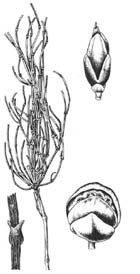
Ali and Qaiser (1987) provide a drawing.

Ephedra procera
Syn. E. major subsp. procera Fisch. et. C.A. Mey. 1844; E. nebrodensis Tineo var. procera (Fisch. et C.A. Mey.) Stapf. Type location in the Caucasus (Ali and Qaiser 1987).
Shrubs up to 2 m tall. Branches and branchlets slender, striate, smooth. Leaves up to 3 mm long, leathery. Male cones sessile, subglobose, 4-5 mm long; anthers 6-8. Female cones erect, solitary, petiolated, with 2-3 pairs of bracts, the inner connate below the middle. Tubillus c. 2.5 mm long, straight. Berry red or yellow, ovoid to subglobose, 5-7 mm long; seeds ovate to oblong, c. 5 mm long. Heartwood red-brown (Ali and Qaiser 1987, Vidakovic 1991). See also the description in Bobrov (1968).
Balkan Peninsula, Asia Minor, Armenia, Kurdistan, Iran, Afghanistan, Pakistan (Baluchistan), Himalaya, Greece. In Greece, in the southern mountains (Ali and Qaiser 1987, Vidakovic 1991).
The IUCN regards this taxon as synonymous with E. major, so there has been no conservation assessment.
No data as of 2023.03.03.
"The plant is medicinal and is used for the extraction of Ephedrine" (Ali and Qaiser 1987).
Ali, S.I. and M. Qaiser (eds.). 1987. Flora of Pakistan. http://www.efloras.org.
Bobrov, E. G. 1968. Ephedraceae, pp. 154-160 in V.L. Komarov (ed.), Flora of the USSR, Vol. 1, trans. by the Israel Program for Scientific Translations. Washington DC: Smithsonian Institution and National Science Foundation. Available: Biodiversity Heritage Library, accessed 2021.12.30.
Last Modified 2023-03-03